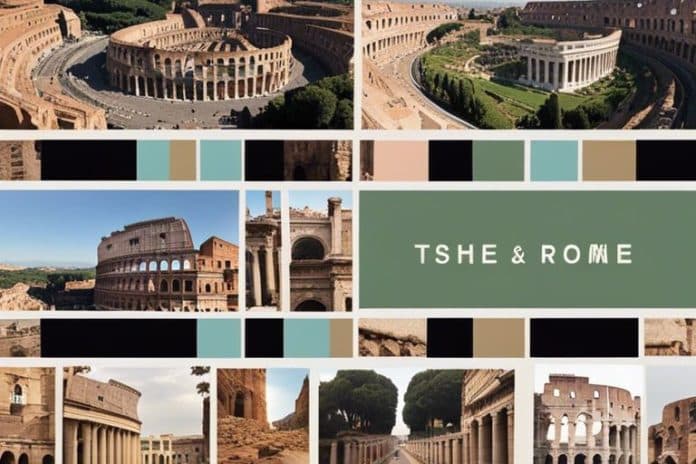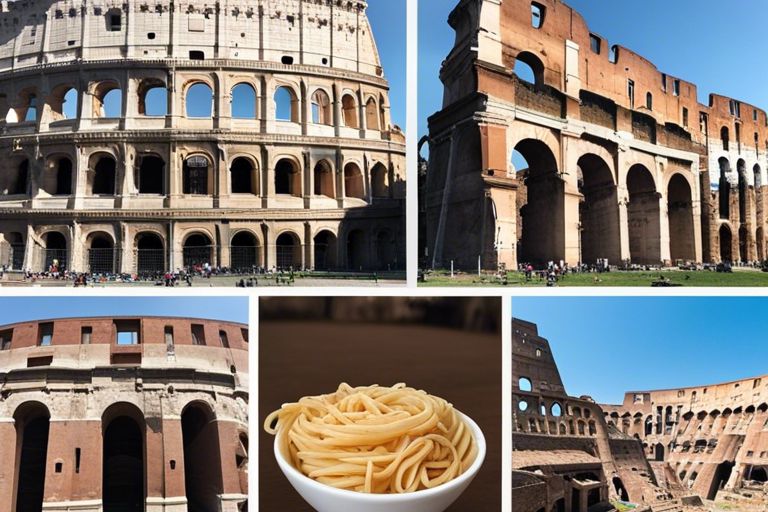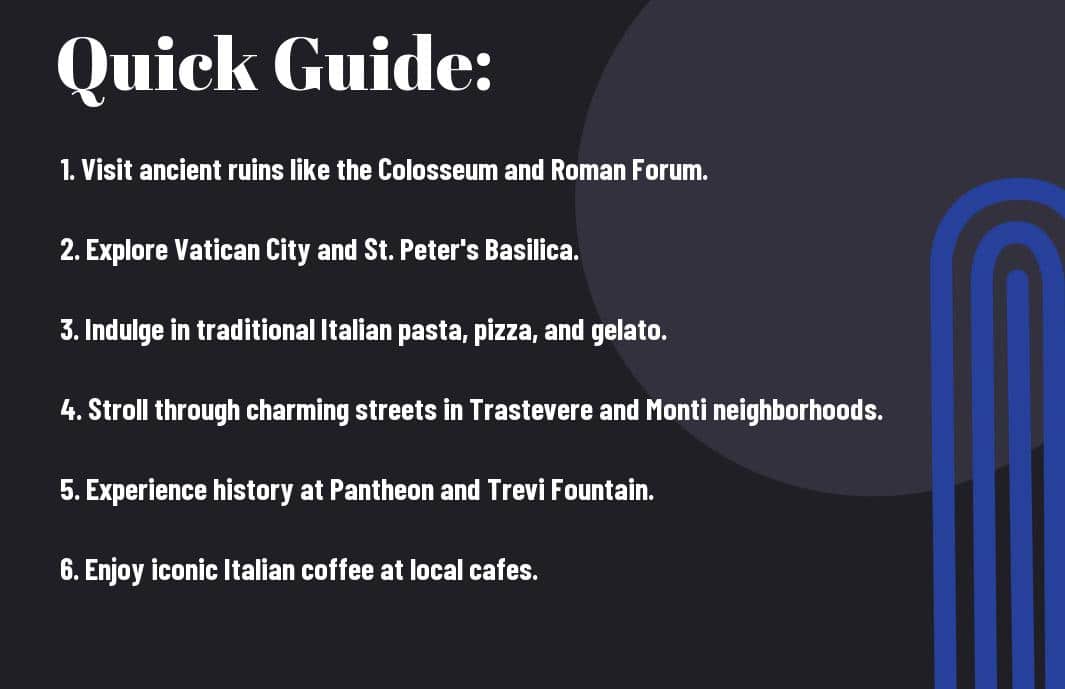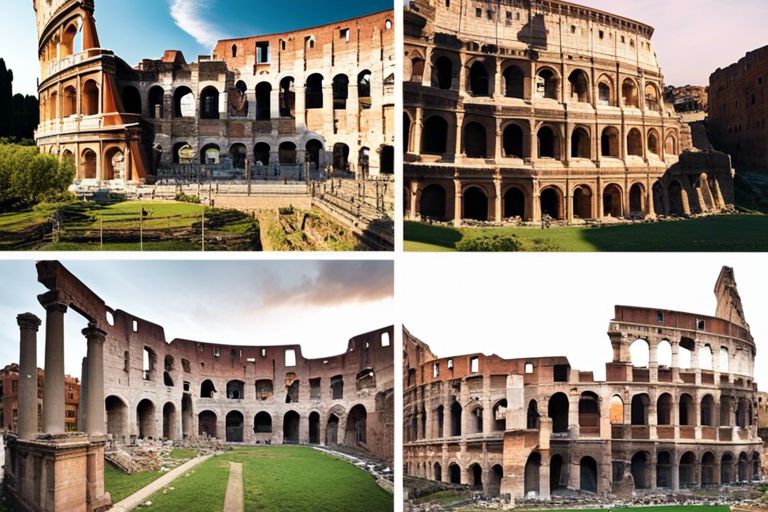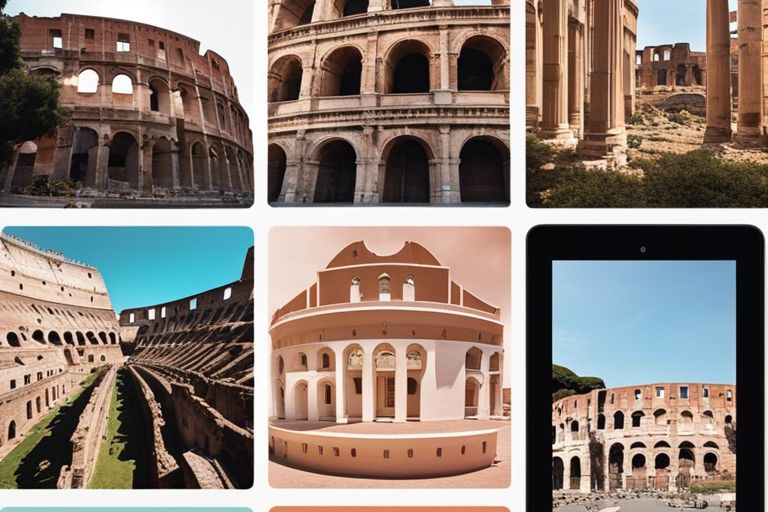Most travelers dream of walking through the ancient ruins of Rome, where every corner tells a story of the powerful Roman Empire. Rome is a city that effortlessly blends history, culture, and cuisine like no other. From the iconic Colosseum to the majestic Vatican City, there is no shortage of world-renowned landmarks to explore.
However, amidst the charm and beauty of Rome lie some hidden dangers that travelers should be aware of. Pickpockets are prevalent in crowded tourist areas, so vigilance is key. Additionally, navigating the city’s streets can be a challenge due to traffic congestion and a maze of narrow alleyways. Despite these risks, with the right preparation and precautions, a trip to Rome can be an unforgettable adventure.
Indulge in heavenly Italian cuisine in Rome, where every meal is an exquisite experience. From authentic pasta dishes to decadent gelato, the city offers a gastronomic journey that is sure to delight your taste buds. Be sure to explore the local markets and family-owned trattorias to savor the true essence of Italian cooking. With its rich history, vibrant culture, and irresistible food, Rome truly is a top travel destination that should be on every explorer’s list.
Key Takeaways:
- Rich Historical Sites: Rome offers a unique opportunity to explore ancient ruins such as the Colosseum, Roman Forum, and Pantheon.
- Culinary Delights: Indulge in heavenly Italian cuisine including pasta, pizza, gelato, and espresso while visiting Rome.
- Vatican City: Explore the world’s smallest independent state within Rome, home to iconic landmarks like St. Peter’s Basilica and the Sistine Chapel.
- Artistic Masterpieces: Admire renowned artworks by Michelangelo, Raphael, and Caravaggio in Rome’s museums and churches.
- Charming Piazzas: Discover picturesque squares like Piazza Navona and Piazza di Spagna, perfect for people-watching and enjoying the local atmosphere.
- Fascinating Architecture: Marvel at Rome’s architectural wonders such as the Trevi Fountain, Spanish Steps, and Castel Sant’Angelo.
- Authentic Italian Culture: Immerse yourself in the vibrant street life, lively markets, and traditional festivities of Rome to experience the essence of Italian culture.
Understanding Rome’s Rich History
The What to See in Rome, Italy – Main Tourist Attractions can leave any history enthusiast in awe. Rome, the Eternal City, is a treasure trove of ancient ruins that speak volumes about its rich history. From the iconic Colosseum to the majestic Pantheon, each site tells a story of the ancient Romans and their remarkable civilization.
A Brief Overview of Ancient Rome
History reveals that Ancient Rome was a powerhouse of innovation and engineering. The Romans were pioneers in architecture, engineering, and governance. They built an extensive network of roads, bridges, and aqueducts that laid the foundation for modern civilization. The Roman Empire spanned across three continents and influenced cultures far and wide.
Ancient Rome also left a lasting impact on art, literature, and philosophy. The Romans excelled in sculpture, painting, and epic poetry, producing timeless works that continue to inspire artists today. Figures like Julius Caesar and Augustus Caesar shaped the course of history and left behind a legacy that is still revered.
The Impact of Roman Civilization on the Modern World
While the mighty Roman Empire may have fallen, its legacy lives on in the modern world. The Roman legal system laid the groundwork for many legal systems in existence today. Concepts such as citizenship, democracy, and civil rights originated in ancient Rome and continue to shape societies around the globe.
The impact of Roman civilization can be seen in architecture, language, and political governance. Many of the world’s languages, including English, French, and Spanish, have roots in Latin, the language of ancient Rome. The principles of Roman engineering and urban planning are evident in modern city layouts and infrastructure.
Types of Ancient Ruins in Rome
Unlike modern buildings that serve a specific purpose, ancient ruins in Rome tell a story of a bygone era. These ruins are not just remnants of the past, but they are a testament to the grandeur and sophistication of ancient Roman civilization. Exploring these historical sites allows visitors to step back in time and appreciate the architectural and engineering marvels that have stood the test of time.
| Public Monuments and Political Spheres | Religious Structures and Temples |
| Colosseum | Pantheon |
| Roman Forum | Temple of Saturn |
| Circus Maximus | Temple of Vesta |
| Theatre of Marcellus | Temple of Castor and Pollux |
| Arch of Constantine | Temple of Hercules Victor |
Public Monuments and Political Spheres
Political power and public life in ancient Rome were centered around monumental structures that served as symbols of authority and governance. The Colosseum, an iconic amphitheater, was the stage for gladiatorial contests and other public spectacles that entertained the masses. The Roman Forum was the heart of political activity, where important decisions were made and public speeches were delivered. The Circus Maximus was a massive chariot racing stadium that showcased the wealth and extravagance of the Roman elite.
These public monuments not only served as venues for entertainment and political discourse but also reflected the grandeur and power of the Roman Empire. The Theatre of Marcellus and the Arch of Constantine are further examples of ancient Roman architecture that blended functionality with artistic expression, leaving a lasting impact on visitors.
After exploring these ancient ruins, visitors can investigate deeper into the political and social dynamics of ancient Rome by visiting The ultimate travel guide to Rome. A city trip to Rome Italy … for a comprehensive understanding of the city’s rich history.
Religious Structures and Temples
For centuries, religious structures and temples in Rome have played a crucial role in the spiritual and cultural life of its inhabitants. The Pantheon, a former Roman temple and now a church, is a remarkable example of ancient Roman engineering and religious devotion. The Temple of Saturn and the Temple of Vesta were dedicated to important deities in the Roman pantheon, reflecting the religious beliefs of the ancient Romans.
These religious structures not only served as places of worship but also as symbols of the divine authority that governed every aspect of Roman life. The Temple of Castor and Pollux and the Temple of Hercules Victor are other examples of Roman temples that have withstood the test of time, offering insights into the religious practices of the ancient Romans.
Structures like these continue to fascinate visitors with their intricate architectural designs and religious significance, providing a glimpse into the spiritual world of ancient Rome.
Entertainment and Social Venues
Rome was not just a center of political and religious significance but also a hub of entertainment and social gatherings. The city’s temples and theaters were venues for theatrical performances, musical concerts, and other forms of artistic expression that brought the community together. The Theatre of Marcellus, for example, hosted dramatic productions that entertained audiences from all walks of life.
Temples like the Temple of Saturn and the Temple of Vesta were not just places of worship but also served as gathering spots for religious festivals and ceremonies that united the Roman populace. The Circus Maximus, with its chariot races and other spectacles, provided a diversion from the everyday struggles of ancient Roman life.
After exploring these ancient ruins and social venues, visitors can gain a deeper understanding of the vibrant cultural life that characterized ancient Rome, making their travel experience truly enriching and enlightening.
Exploring Roman Cuisine: A Gastronomic Journey
The Essentials of Roman Dishes
One of the imperative aspects of Roman cuisine is its simplicity and focus on quality ingredients. Roman dishes often feature fresh vegetables, herbs, olive oil, and cheeses. Pasta plays a significant role in the Roman diet, with classics like Cacio e Pepe and Amatriciana stealing the hearts of both locals and visitors alike. The cuisine also emphasizes the use of seasonal produce, making each dish a celebration of the flavors of the moment.
Essentials also include Roman culinary traditions handed down through generations, such as the art of slow-cooking meats and stews to tender perfection. The emphasis on regional flavors and the use of locally sourced ingredients give Roman dishes their distinctive taste and charm. When in Rome, experiencing the authentic flavors of traditional Roman cuisine is a must for any food enthusiast.
Furthermore, exploring Roman dishes goes beyond tasting the food; it is an immersion into the city’s rich culinary history and cultural heritage. From ancient recipes passed down from the Roman Empire to modern interpretations that blend tradition with innovation, every bite tells a story of Rome’s gastronomic evolution.
Street Food Vs. Fine Dining in Rome
Essentials when it comes to dining in Rome is the duality of street food and fine dining options available throughout the city. While fine dining restaurants offer a lavish culinary experience with meticulously prepared dishes and elegant ambiance, street food stalls and markets provide a quick and casual way to indulge in Roman flavors.
Exploring both street food and fine dining establishments allows visitors to experience the diverse gastronomic landscape of Rome. Whether enjoying a gourmet meal at a Michelin-starred restaurant or savoring a classic Roman pizza bianca from a local bakery, each dining experience offers a unique perspective on the city’s culinary scene.
For those looking to truly immerse themselves in the local food culture, a combination of street food and fine dining is recommended. This way, visitors can appreciate the contrast between the simplicity of traditional Roman street food and the sophistication of high-end dining while discovering the nuances that make Roman cuisine truly exceptional.
Famous Roman Ingredients and Where to Find Them
Gastronomic delights in Rome are often made possible by the use of premium ingredients that are emblematic of the city’s culinary identity. From the distinctive flavor of pecorino romano cheese to the tangy sweetness of San Marzano tomatoes, these ingredients elevate Roman dishes to new heights of taste and authenticity.
Roman markets and specialty stores are the ideal places to source these famous ingredients, allowing visitors to bring a piece of Roman cuisine back home with them. Whether exploring the bustling stalls of Campo de’ Fiori or browsing the shelves of historic gourmet shops, discovering these premium ingredients adds a touch of Roman flair to any home-cooked meal.
To truly savor the essence of Roman cuisine, incorporating these famous ingredients into your dishes is key. Whether using them as the star of a classic Roman recipe or putting a modern twist on a traditional favorite, the flavors of Rome’s renowned ingredients are sure to transport you to the heart of the Eternal City with every bite.
Planning Your Trip: Steps to a Memorable Roman Holiday
Despite the abundance of information available online, planning a trip to Rome can be overwhelming. Follow these step-by-step guidelines to ensure a smooth and unforgettable vacation. Start by determining your travel dates and budget, then research flights and accommodation options. Once you have your basic itinerary in place, consider booking guided tours of Rome’s iconic attractions like the Colosseum, Vatican City, and the Roman Forum.
Step-by-Step Itinerary Planning
| Step 1 | Determine travel dates and budget |
| Step 2 | Research flights and accommodation |
| Step 3 | Book guided tours of major attractions |
Little details like purchasing skip-the-line tickets can make a big difference in maximizing your time in Rome. Consider creating a flexible itinerary that allows for spontaneous discoveries and leisurely evenings spent dining at local trattorias. By planning ahead and staying organized, you can make the most of your Roman holiday and create lasting memories.
Factors to Consider When Traveling to Rome
| Season | Peak tourist season vs. off-peak travel |
| Local Customs | Respect cultural norms and dress codes |
| Transportation | Public transit options and taxi services |
Rome’s cobblestone streets and historic sites can be both enchanting and challenging to navigate. Be prepared for long walks and crowded attractions, but don’t forget to savor the city’s culinary delights and vibrant nightlife. Keep your belongings secure and be cautious of pickpockets in busy tourist areas. Any valuables should be stored safely in your hotel room or accommodation.
Rome is a city of contrasts, where ancient ruins blend seamlessly with modern amenities. Visitors can immerse themselves in the rich history of the Roman Empire while enjoying world-class shopping and dining experiences. The city’s bustling streets can be chaotic at times, but this only adds to the excitement of exploring a destination with such a storied past.
Practical Tips for Touring Ancient Ruins
Many travelers dream of exploring Rome’s ancient ruins to get a glimpse into the city’s rich history. However, navigating these historic sites can be overwhelming without proper planning and knowledge. To make the most of your visit, it’s necessary to follow these practical tips to ensure a smooth and enjoyable experience.
Purchasing Tickets and Skipping the Lines
An important aspect of touring ancient ruins in Rome is purchasing tickets in advance to avoid long lines and potential disappointment. Many popular sites, such as the Colosseum and Roman Forum, offer skip-the-line tickets that allow you to bypass the queues and gain direct access to the attractions. It’s highly recommended to book these tickets online or through reputable tour operators to secure your spot and save time.
Another tip is to visit the sites early in the morning or later in the evening to avoid the crowds and make the most of your visit. This way, you can explore the ancient ruins at your own pace without feeling rushed or overwhelmed by the throngs of tourists.
Recognizing the value of pre-booked tickets and strategic timing can greatly enhance your experience of touring Rome’s ancient ruins while also ensuring a hassle-free and memorable visit.
Respectful Conduct at Historic Sites
An important aspect of visiting ancient ruins is showing respect for the historic sites and the people who once inhabited them. While exploring these remnants of the past, it’s crucial to follow the rules and regulations in place to preserve the integrity of the sites for future generations.
Visitors should refrain from touching or defacing the ancient structures, as this can cause irreversible damage to the historical artifacts. It’s also important to avoid littering and to dispose of trash properly to maintain the cleanliness of the sites.
This respectful conduct not only helps preserve Rome’s ancient ruins but also contributes to a more pleasant and meaningful experience for all visitors.
Accessibility and Comfort Recommendations
With Rome’s ancient ruins spanning vast areas and sometimes challenging terrain, it’s necessary to consider accessibility and comfort during your visit. Wear comfortable shoes and clothing, as you may be walking long distances and exploring uneven surfaces.
Carrying a refillable water bottle and sunscreen is also advisable, especially during the hot summer months when temperatures can soar. Additionally, consider bringing a hat and sunglasses to protect yourself from the sun while exploring the outdoor sites.
Recommendations such as wearing appropriate attire and staying hydrated can greatly enhance your comfort and overall experience while touring Rome’s ancient ruins.
Savoring Roman Cuisine: Tips and Etiquette
Once again, exploring a new destination means delving into its culinary treasures. In Rome, dining etiquette is important for a truly authentic experience. To fully savor the flavors of Roman cuisine, it’s important to follow some tips and rules. From understanding the different types of eateries to navigating dietary concerns, mastering the art of dining in Rome will enhance your overall travel experience.
Understanding the Different Types of Eateries
When dining in Rome, you’ll encounter various types of eateries offering unique culinary experiences. From trattorias serving traditional Roman dishes to osterias specializing in local wines and simple fare, each establishment has its charm. Recognizing the differences between a pizzeria and a gelateria will help you choose the perfect dining spot for each meal.
| Trattoria | Cozy, family-run restaurants serving hearty, home-cooked meals at affordable prices. |
| Osteria | Small, casual eateries offering wine and a limited menu of traditional Roman dishes. |
| Pizzeria | Places specializing in authentic Roman pizzas baked in wood-fired ovens. |
| Gelateria | Shops dedicated to crafting delicious gelato in a variety of flavors. |
| Ristorante | Upscale restaurants serving gourmet Italian cuisine with a focus on quality ingredients. |
Tips for a Heavenly Culinary Experience
If you want to make the most of your dining experience in Rome, follow these tips for a heavenly culinary adventure. Start by tasting authentic cacio e pepe (cheese and pepper pasta) at a local trattoria, and pair it with a glass of frascati wine for a true Roman feast. To experience the best of Roman street food, head to Campo de’ Fiori for some supplì or porchetta. Recognizing the nuances of Roman cuisine will enrich your gastronomic journey.
Dietary Concerns and How to Navigate Them
Types of dietary concerns like food allergies or preferences can pose a challenge while dining in a foreign country. In Rome, it’s crucial to communicate your dietary needs clearly to ensure a safe and enjoyable dining experience. Whether you’re vegetarian, vegan, or have specific allergies, most eateries in Rome are accommodating and willing to cater to your requirements. Recognizing the importance of dietary concerns will enable you to explore Roman cuisine safely and with confidence.
Ordering dishes in Rome can be an exciting yet daunting task, especially if you have dietary concerns. Ensure to communicate any food allergies or intolerances to the server clearly. It’s important to highlight the ingredients you need to avoid, such as gluten or dairy, to prevent any mishaps. Additionally, seek recommendations from the staff for dishes that align with your dietary restrictions. By being proactive and informed when ordering, you can enjoy a safe and satisfying meal while exploring the culinary delights of Rome.
Pros and Cons of Travel Destinations Within Rome
Major Ruins and Their Drawbacks
To truly experience the grandeur of ancient Rome, a visit to major ruins such as the Colosseum and the Roman Forum is a must. These iconic landmarks offer a glimpse into the city’s rich history, allowing visitors to step back in time and imagine what life was like in ancient Rome. However, one significant drawback of these popular sites is the large crowds that flock to them every day. Navigating through throngs of tourists can be overwhelming and detract from the overall experience of exploring these remarkable ruins.
The Hidden Gems and Their Advantages
The
While the major ruins in Rome attract the majority of tourists, the city is also home to many hidden gems waiting to be discovered. These lesser-known sites, such as the Baths of Caracalla and the Appian Way, offer a more intimate and authentic Roman experience. The advantages of visiting these hidden gems include fewer crowds, allowing visitors to explore at their own pace and truly appreciate the beauty and history of these ancient sites.
Moreover, exploring these hidden gems provides a unique opportunity to uncover the lesser-known stories and secrets of ancient Rome. From underground catacombs to scenic gardens, these sites offer a different perspective on the history and culture of the city, making them a must-visit for travelers seeking a deeper connection to Rome’s past.
Navigating Tourist Crowds and Finding Serenity
Assuming
One of the biggest challenges of exploring popular travel destinations within Rome is navigating the sea of tourists that flood the city’s streets and attractions. The crowds can often make it difficult to fully appreciate the beauty and significance of the sites, leading to a less fulfilling experience for visitors. Finding moments of serenity amidst the chaos can be a daunting task but is necessary for those looking to truly immerse themselves in the magic of Rome.
Plus, strategically planning your visits to popular sites during off-peak hours can help minimize the impact of tourist crowds. Early mornings or late evenings are ideal times to explore iconic landmarks such as the Vatican Museums or the Trevi Fountain without having to compete with hordes of other visitors. Additionally, seeking out lesser-known attractions and off-the-beaten-path locations can provide a peaceful respite from the hustle and bustle of the city center.
Capturing Memories: Photography Tips for Ancient Sites and Cuisine
Keep your camera ready to capture the breathtaking beauty of Rome’s ancient ruins and the exquisite details of its heavenly cuisine. Whether you are exploring the Colosseum or indulging in a plate of authentic pasta carbonara, there are plenty of opportunities to snap memorable photos that will transport you back to your time in the Eternal City.
Best Practices for Photographing Ruins
Clearly, when photographing ancient sites like the Roman Forum or the Pantheon, it is necessary to pay attention to detail. Focus on capturing the intricate architecture and the storied history of each location. Experiment with different angles and perspectives to showcase the grandeur of these archaeological wonders. Remember to highlight the unique features that make each site special, whether it’s the worn marble columns or the mosaic floors.
When photographing ruins, it’s important to consider the time of day and how the light interacts with the ancient structures. Early morning or late afternoon light can create dramatic shadows and illuminate the textures of the ruins. Be patient and wait for the perfect moment to capture the essence of these historic landmarks. The key is to preserve the authenticity of the ruins while adding your own creative touch to the images.
The key to successful photography at ancient sites is to immerse yourself in the surroundings and let the centuries of history inspire your compositions. Take your time to explore different vantage points and experiment with framing to create visually stunning images. The more you connect with the ruins, the more impactful your photographs will be in preserving the magic of Rome’s past.
Lighting and Composition Considerations for Food Photography
Clearly, when photographing Rome’s heavenly cuisine, lighting and composition play a crucial role in capturing the essence of the dishes. Soft, natural light is ideal for food photography as it enhances colors and textures without creating harsh shadows. Consider setting up near a window or using a diffuser to achieve a soft, flattering light on your plates.
Food photography is all about composition and styling. Pay attention to the arrangement of the dishes, the use of props, and the angles from which you shoot. Experiment with different compositions to find the most visually appealing presentation for each dish. Remember to focus on the details like the garnishes, textures, and colors that make each dish unique.
Food photography allows you to tell a story through your images, conveying the flavors and atmosphere of a dining experience. Think about the emotions you want to evoke in viewers and use lighting and composition to enhance the narrative. With careful attention to detail and creative flair, you can capture the essence of Rome’s culinary delights in stunning photographs that will make your mouth water.
Staying Safe and Healthy in Rome
Health Precautions and Insurance
After planning your trip to Rome, it’s necessary to consider your health and safety while traveling. While Rome is a relatively safe city, it’s always wise to take some health precautions before your trip. Make sure you have travel insurance that covers medical emergencies, including hospital stays, doctor’s visits, and repatriation if necessary. Additionally, pack necessary medications and a first-aid kit to handle any minor health issues that may arise during your travels.
When traveling to Rome, it’s advisable to be mindful of the local cuisine and potential food-related health concerns. Ensure that you drink bottled water to avoid any contamination risks and be cautious of street food vendors to prevent foodborne illnesses. Furthermore, familiarize yourself with the location of nearby medical facilities in case of any emergencies, and carry necessary documents like health insurance cards and emergency contact information with you at all times.
Having proper health precautions in place will give you peace of mind during your travels in Rome and ensure that you can enjoy your trip to the fullest without worrying about unexpected health issues derailing your plans.
Safety Tips for Tourists
Staying safe while exploring Rome is paramount to having a pleasant and hassle-free travel experience. When visiting popular tourist attractions like the Colosseum or the Vatican, be cautious of pickpockets and keep your belongings secure at all times. Avoid carrying large amounts of cash and use a money belt or a secure bag to protect your valuables.
- Stay alert in crowded areas and be aware of your surroundings
- Avoid isolated or poorly lit areas, especially at night
Knowing the common scams in Rome, such as fake petitions or distraction techniques used by thieves, can help you stay vigilant and protect yourself from potential risks. By staying informed and practicing caution, you can ensure a safe and enjoyable visit to the Eternal City.
Reflecting on Rome’s Timeless Allure
Rome’s enchanting beauty and rich history have captivated travelers for centuries, making it a must-visit destination for history buffs and art enthusiasts alike. The city’s ancient ruins, such as the Roman Forum and Pantheon, serve as a testament to its enduring legacy and offer a glimpse into the past glory of the Roman Empire.
The picturesque streets lined with charming cafes and gelaterias provide the perfect setting to immerse yourself in the local culture and savor authentic Italian cuisine. From indulging in traditional dishes like pasta carbonara and pizza margherita to sampling delectable pastries and espresso, Rome offers a culinary experience like no other.
Exploring Rome’s timeless allure allows you to unlock the secrets of its storied past while indulging in the vibrant present-day culture that thrives within its ancient walls. Whether strolling through cobblestone streets or marveling at world-renowned art collections, Rome’s allure is sure to leave a lasting impression on every traveler who visits.
The Enduring Legacy of Rome’s Ruins and Cuisine
Reflecting on Rome’s majestic ruins and exquisite cuisine, one cannot help but be mesmerized by the city’s enduring legacy that continues to captivate visitors from around the world. The juxtaposition of ancient architectural wonders like the Colosseum and Palatine Hill against the backdrop of bustling trattorias and gelaterias creates a unique tapestry that showcases the city’s rich history and culinary traditions.
The mouthwatering flavors of Italian cuisine paired with the awe-inspiring ruins of Rome create a sensory experience that transcends time, allowing visitors to connect with the past while savoring the present. From sipping on a refreshing Aperol Spritz overlooking the Trevi Fountain to exploring the underground catacombs of the Vatican, Rome’s enduring legacy invites you to probe into a world where history and gastronomy converge harmoniously.
The blend of ancient ruins and heavenly cuisine in Rome offers a journey of discovery that tantalizes the senses and leaves an indelible mark on every traveler’s heart. Whether marveling at architectural marvels or indulging in mouthwatering dishes, Rome’s enduring legacy is a testament to the city’s timeless appeal and unwavering charm.
FAQ
Q: What are the must-visit ancient ruins in Rome?
A: The must-visit ancient ruins in Rome include the Colosseum, Roman Forum, Palatine Hill, Pantheon, and the Baths of Caracalla.
Q: What is the best time of year to visit Rome?
A: The best time to visit Rome is during the spring (April to June) or fall (September to October) when the weather is pleasant, and the crowds are smaller compared to the peak summer months.
Q: What is the traditional cuisine of Rome?
A: The traditional cuisine of Rome is known for dishes such as pasta carbonara, cacio e pepe, supplì (fried rice balls), Roman artichokes, and gelato.
Q: What are some popular attractions in Rome besides ancient ruins?
A: Some popular attractions in Rome besides ancient ruins include Vatican City and St. Peter’s Basilica, Trevi Fountain, Spanish Steps, Villa Borghese, and Trastevere neighborhood.
Q: Is it safe to drink tap water in Rome?
A: Yes, it is safe to drink tap water in Rome as the city has high-quality drinking water that is safe for consumption.
Q: What is the currency used in Rome?
A: The currency used in Rome, as in the rest of Italy, is the Euro (€).
Q: How can I get around Rome easily?
A: Getting around Rome is easy with public transportation options such as buses, trams, and the metro. Taxis and ride-sharing services are also available for convenient travel within the city.
